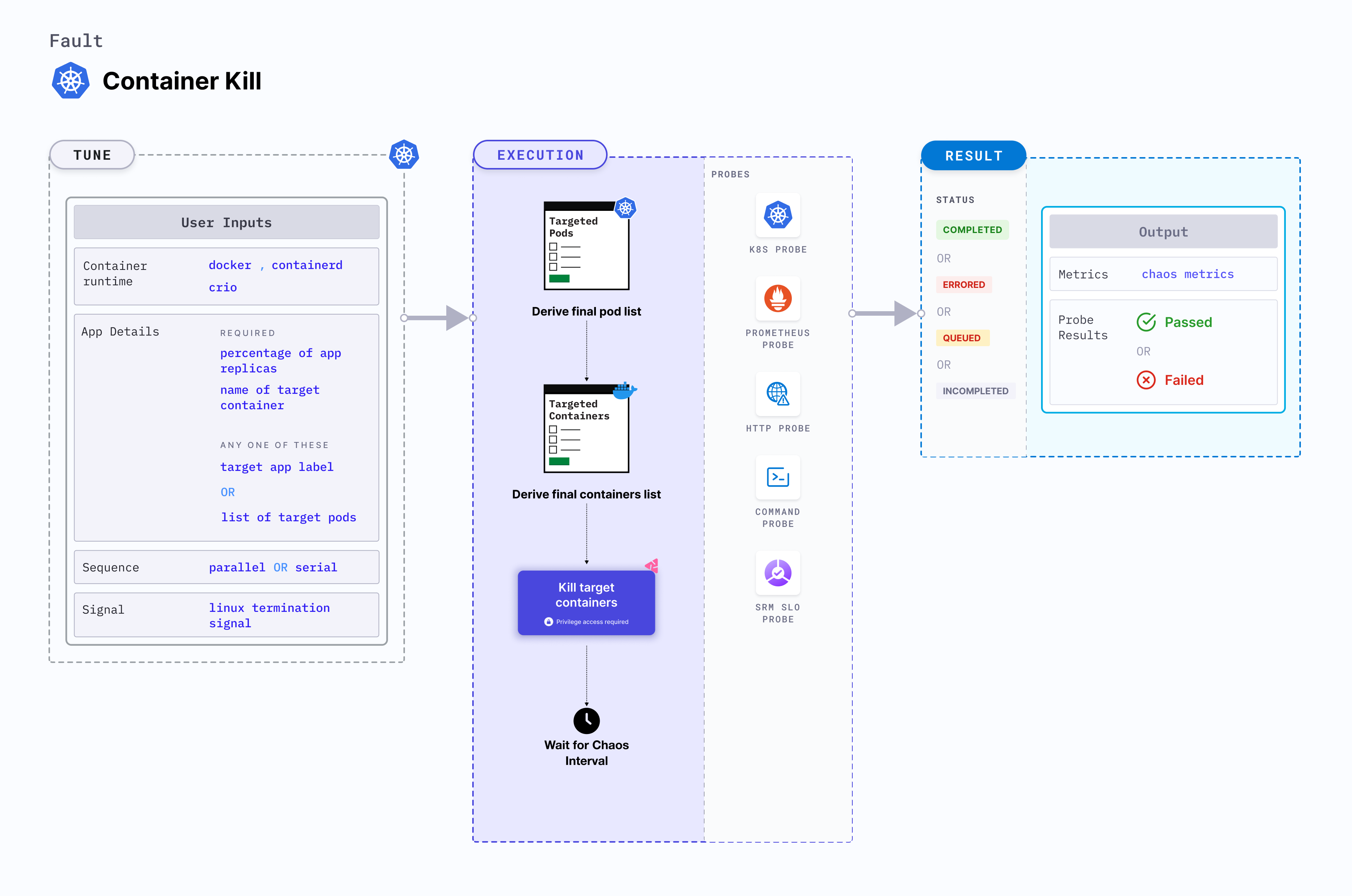Container kill
Container kill is a Kubernetes pod-level chaos fault that causes container failure on specific or random replicas of an application resource.

Use cases
Container kill:
- Tests an application's deployment sanity (replica availability and uninterrupted service) and recovery workflow when certain replicas are not available.
- Tests the recovery of pods that possess sidecar containers.
Prerequisites
- Kubernetes > 1.16
- The application pods should be in the running state before and after injecting chaos.
Optional tunables
| Tunable | Description | Notes |
|---|---|---|
| TARGET_CONTAINER | Name of the container that is killed. | If it is not provided, the fault deletes the first container. For more information, go to kill specific container |
| CHAOS_INTERVAL | Time interval between two successive container kills (in seconds). | Default: 10 s. For more information, go to chaos interval |
| TOTAL_CHAOS_DURATION | Duration for which to insert chaos (in seconds). | Default: 20 s. For more information, go to duration of the chaos |
| PODS_AFFECTED_PERC | Percentage of total pods to target. It takes numeric values only. | Default: 0 (corresponds to 1 replica). For more information, go to pod affected percentage |
| TARGET_PODS | Comma-separated list of application pod names subject to container kill. | If it is not provided, target pods are randomly based on appLabels provided. For more information, go to target specific pods |
| NODE_LABEL | Node label used to filter the target node if TARGET_NODE environment variable is not set. | It is mutually exclusive with the TARGET_NODE environment variable. If both are provided, the fault uses TARGET_NODE. For more information, go to node label. |
| RAMP_TIME | Period to wait before injecting chaos (in seconds). | For example, 30 s. For more information, go to ramp time |
| SEQUENCE | Sequence of chaos execution for multiple target pods. | Default value: parallel. Supports serial and parallel. For more information, go to sequence of chaos execution |
| SIGNAL | Termination signal used for container kill. | Defaults to SIGKILL. For more information, go to signal for kill |
| SOCKET_PATH | Path to the containerd/crio/docker socket file. | Default /run/containerd/containerd.sock. For more information, go to socket path |
| CONTAINER_RUNTIME | Container runtime interface for the cluster. | Default: containerd. Supports docker, containerd and crio. For more information, go to container runtime |
Kill specific container
Name of the target container. Tune it by using the TARGET_CONTAINER environment variable. If TARGET_CONTAINER environment variable is set to empty, the fault uses the first container of the target pod.
The following YAML snippet illustrates the use of this environment variable:
# kill the specific target container
apiVersion: litmuschaos.io/v1alpha1
kind: ChaosEngine
metadata:
name: engine-nginx
spec:
engineState: "active"
annotationCheck: "false"
appinfo:
appns: "default"
applabel: "app=nginx"
appkind: "deployment"
chaosServiceAccount: litmus-admin
experiments:
- name: container-kill
spec:
components:
env:
# name of the target container
- name: TARGET_CONTAINER
value: "nginx"
- name: TOTAL_CHAOS_DURATION
VALUE: "60"
Container runtime and socket path
The CONTAINER_RUNTIME and SOCKET_PATH environment variables to set the container runtime and socket file path, respectively.
CONTAINER_RUNTIME: It supportsdocker,containerd, andcrioruntimes. The default value iscontainerd.SOCKET_PATH: It contains path of containerd socket file by default(/run/containerd/containerd.sock). Fordocker, specify path as/var/run/docker.sock. Forcrio, specify path as/var/run/crio/crio.sock.
The following YAML snippet illustrates the use of these environment variables:
## provide the container runtime and socket file path
apiVersion: litmuschaos.io/v1alpha1
kind: ChaosEngine
metadata:
name: engine-nginx
spec:
engineState: "active"
annotationCheck: "false"
appinfo:
appns: "default"
applabel: "app=nginx"
appkind: "deployment"
chaosServiceAccount: litmus-admin
experiments:
- name: container-kill
spec:
components:
env:
# runtime for the container
# supports docker, containerd, crio
- name: CONTAINER_RUNTIME
value: "containerd"
# path of the socket file
- name: SOCKET_PATH
value: "/run/containerd/containerd.sock"
- name: TOTAL_CHAOS_DURATION
VALUE: "60"
Signal for kill
Linux signal passed when killing the container. Its default value is set to SIGTERM. Tune it by using the SIGNAL environment variable.
The following YAML snippet illustrates the use of this environment variable:
# specific linux signal passed while kiiling container
apiVersion: litmuschaos.io/v1alpha1
kind: ChaosEngine
metadata:
name: engine-nginx
spec:
engineState: "active"
annotationCheck: "false"
appinfo:
appns: "default"
applabel: "app=nginx"
appkind: "deployment"
chaosServiceAccount: litmus-admin
experiments:
- name: container-kill
spec:
components:
env:
# signal passed while killing container
# defaults to SIGTERM
- name: SIGNAL
value: "SIGKILL"
- name: TOTAL_CHAOS_DURATION
VALUE: "60"